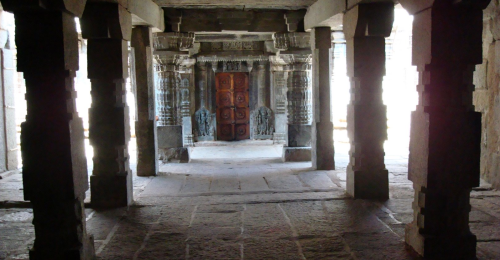(Image by backpacker)
The Indian History Carnival, published on the 15th of every month, is a collection of posts related to Indian history and archaeology written in the past 30 days.
-
Sukumar attends a lecture by Asko Parpola on the Indus Valley script which disproves the Farmer/Witzel/Sproat theory that Indus Valley Civilization was illiterate.
-
Arvind Sharma finds out what ancient Indians thought about ancient Greeks and writes about the account of an Indian meeting Socrates. He has another post about the the Greek accounts of India.
-
Stephanie laughts at the outrageous reports of Herodotus, especially the gold digging ants of India.
-
illlaaa writes about the battle in India that stopped Alexander of Macedonia.
-
Priya finds it hard to believe Asoka’s change of heart after the Kalinga war.
-
Here at varnam, we had the Spicy history of Malabar about times when Kerala was part of the global economy.
- Manan Ahmed takes Amartya Sen to task for his “particularly cataracted vision of Indian history” and notes the similarity of thought with Karl Marx.
-
In 1750, India’s contribution to world GDP was 25% and by the time the British left we were poor. Raj says don’t the blame the British for, ” with or without the British ruling India, the former was well placed to usher in the industrial revolution and reap the full benefits.” (via DesiPundit)
-
Bala writes about the “Anti-Charitable Contributions Act of 1877”, meant to punish people for donating to the poor and the needy during famines. This resulted in the death of 10 million people. (via email from Ravages)
-
Chandrahas quotes from Iranian philosopher Ramin Jahanbegloo’s new book The Spirit of India on freedom as understood by Gandhi both in the personal and in the political sense.
-
The book that is getting lot of coverage is Ramachandra Guha’s India After Gandhi: The History of the World’s Largest Democracy. Patrix has some thoughts on this 900 page book. In his notes about the book, Hari narrates the tale of how refugee farmers were resettled in Punjab.
-
Apollo writes, “He [Army Chief Gen Deepak Kapoor] doesn’t seem to realise that technically India and China do not share a border” and corrects the ignorance of the history of the India-China border issue.
-
Recently the Prince of Arcot disrupted an exhibition showing the Mughal emperor Aurangzeb’s intolerant policies against his subjects. Nitin finds that this Prince of Arcot is still recognized by the Government and has the position of a Cabinet Minister, all due to a promise given to Queen Victoria.
-
Our modern day Huen Tsang, backpakker, takes a detour and reaches Nuggehalli.
-
Rajan Srinivasan had great pictures of Erumbeeswarar Temple at Thiruverumbur which were built by the Cholas.
If you find any posts related to Indian history published in the past one month, please send it to jk AT varnam DOT org or use this form. The next carnival will be posted on April 15th.
See Also: Previous Carnivals
Technorati Tags: Indian History Carnival

